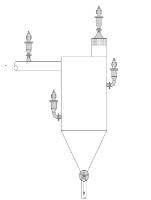 Add My Company
Add My Company
Sign In

Silos: the risks
If silos are filled with powdery products there is, during the filling process, usually an explosive mixture present in the silo. When filling with granular products, also an enormous dust cloud develops in the silo (caused by the dust, always present in between the granules). Extensive measuring by ISMA, however, has proved that the dust concentration is often below the lower explosion limit. This does not mean that there is no explosion risk, after all, dust deposits can be whirled up, but the risk is obviously much smaller than with an explosive cloud.
Silos: the ignition sources
Ignition sources can originate somewhere else and be transported to the silo (see also “Elevators” and “Pneumatic transport”). But ignition sources can also originate in the silo itself. Some specific examples for silos:
Cone discharges: These can come into being in huge silos that are filled with granular products by means of pneumatic transport. This phenomenon is well known, so a judgement on the risks can, case by case, be passed immediately.
Spontaneous combustion: In case of long term storage of organic products, such as grain, spontaneous combustion is far from imaginary, especially if the humidity content is high.
Silos: how to protect them
Transport
By applying appropriate measures to conveying systems (see figure), you can prevent that ignition sources are transported towards the silo. If from calculations it is found that cone discharges are a potential problem, these can be resolved by rather simple means.
Smouldering fires
One of the greatest (and most fearsome) problems is the development of a smouldering fire in a silo. The risk of this happening can be reduced by a good entrance check on the product and a limitation of the storage period. In case of long term storage it may be necessary to regularly “pump around” the product. If, in spite of all preventive measures, it actually comes to a smouldering fire
in the silo, it is absolutely imperative to call in specialists. It often happens that smouldering fires frequently go together with bridge formation. If such a bridge collapses, a heavy explosion may follow.
Constructive protection
Existing silos are often very difficult to protect constructively. But sometimes, by choosing the right combination of preventive measures, an adequate protection can nevertheless be obtained. In spite of all these preventive measures, new silos are often protected constructively, as the consequences of a non-protected dust explosion can be enormous. Explosion suppression of huge silos is often no real option, due to the high cost. For smaller silos and bunkers explosion suppression can certainly be considered..
Isolation
With silos too, enough attention must be given to isolation. With the latter it is particularly important to prevent an explosion to propagate from one silo to another. This can happen through the filling system. But often the silos are also connected to a common exhaust system.
For more information on Silos: explosion and fire hazard talk to StuvEx Safety Systems Ltd
Enquire Now
More related to Silos: explosion and fire hazard
List your company on FindTheNeedle.
